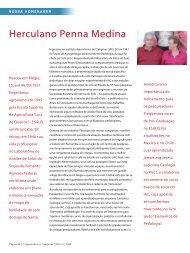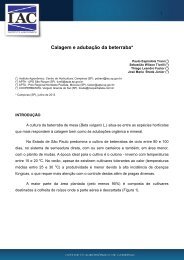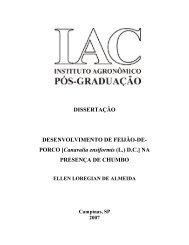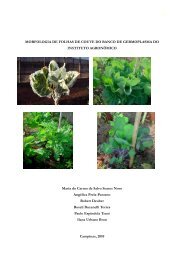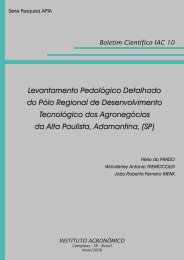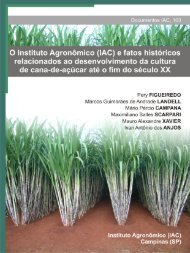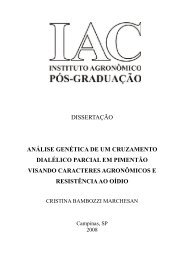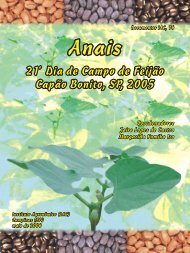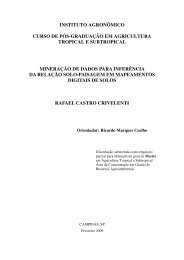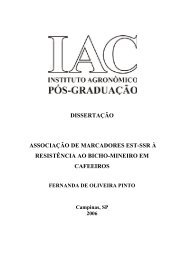vi seminário sobre pragas, doenças e plantas daninhas do ... - IAC
vi seminário sobre pragas, doenças e plantas daninhas do ... - IAC
vi seminário sobre pragas, doenças e plantas daninhas do ... - IAC
- No tags were found...
Create successful ePaper yourself
Turn your PDF publications into a flip-book with our unique Google optimized e-Paper software.
length is short and the temperatures vary from 15 to 25ºC. Chemical control is expensive and can be<br />
poorly efficient when applied alone. Several Trichoderma species are natural antagonists to S. sclerotiorum<br />
sclerotia in soil. However, in general the development of the isolates applied as biocontrol agents is<br />
favoured by temperatures above 25ºC. In this case, the use of these isolates on autumn-winter crops can<br />
be not efficient. The objective of this work was to select Trichoderma spp. isolates able to parasitate the<br />
pathogen sclerotia in lower temperatures. Tweenty isolates were evaluated. Sclerotia were buried on soil<br />
and the following treatments were applied: check; Trichoderma spp. isolates (300 L/ha suspension volume<br />
at 10 7 conidia/mL); and, fungicide (Cerconil, recommended <strong>do</strong>se). After five days at 22±2ºC, the sclerotia<br />
were removed form soil and transferred to carrot slices over water-agar medium. The number of germinated<br />
and parasitized sclerotia was accessed after 10 days. The experiment was conduced twice in a completely<br />
ran<strong>do</strong>mized designed with seven replications. The isolates ALF111 and ALF409 consistently inhibited the<br />
germination and parasitized more than 80% of the sclerotia. Beside these, the isolates ALF02, ALF57,<br />
ALF324 and ALF402 were efficient too. The isolate 172H inhibited significantly germination, but it was not<br />
capable to parasitize the sclerotia, which suggests that other biocontrol mechanisms, such as antibiosis,<br />
are involved. It was concluded that the selected isolates are potential biocontrol agents against the bean<br />
white mold on autumn-winter crops.<br />
Key words: Phaseolus vulgaris L., white-mold, biological control.<br />
1. INTRODUÇÃO<br />
O mofo-branco, causa<strong>do</strong> por Sclerotinia sclerotiorum (Lib.) de Bary, é uma das <strong>do</strong>enças mais<br />
destrutiva <strong>do</strong> feijoeiro (Phaseolus vulgaris L.), especialmente nos plantios irriga<strong>do</strong>s de outono-inverno,<br />
quan<strong>do</strong> os dias são mais curtos e as temperaturas amenas (15-25 o C). A <strong>do</strong>ença é mais prejudicial<br />
quan<strong>do</strong> há crescimento vegetativo abundante, pouco arejamento e penetração da luz, drenagem <strong>do</strong><br />
solo insuficiente e rotações de cultura inadequadas (Paula Jr. e Zambolim, 2006).<br />
O controle químico é caro, os riscos de contaminação <strong>do</strong> ambiente são altos e, como medida<br />
isolada, pode ter eficiência baixa. Além das práticas culturais, o uso de agentes de biocontrole (ACB)<br />
pode contribuir para a redução <strong>do</strong> inóculo <strong>do</strong> patógeno no solo. A presença de microrganismos<br />
antagônicos no solo afeta a <strong>sobre</strong><strong>vi</strong>vência <strong>do</strong>s escleródios de S. sclerotiorum e reduz paulatinamente<br />
o potencial de inóculo. Mais de 30 espécies de fungos e bactérias são relatadas como antagonistas<br />
ou parasitas <strong>do</strong> patógeno (Whipps e Budge, 1990). Entre estes destacam-se várias espécies de<br />
Trichoderma. O antagonista se associa aos escleródios, causa sua degradação ou impede-os de<br />
germinar. A <strong>sobre</strong><strong>vi</strong>vência <strong>do</strong> patógeno nas áreas irrigadas <strong>do</strong> cerra<strong>do</strong> foi reduzida pela presença de<br />
isola<strong>do</strong>s de Trichoderma sp. associa<strong>do</strong>s aos escleródios (Arancibia et al., 2001). Espécies de<br />
Trichoderma prevalecem em ambientes úmi<strong>do</strong>s e podem ser isoladas de todas as zonas climáticas<br />
(Klein e Everleigh, 1998). O desenvol<strong>vi</strong>mento das espécies de Trichoderma mais utilizadas como<br />
ACB é favoreci<strong>do</strong> por temperaturas acima de 25 o C. O uso desses agentes em áreas e/ou épocas de<br />
temperaturas amenas pode ser pouco eficiente (Bernardes, 2006). O objetivo deste trabalho foi<br />
selecionar isola<strong>do</strong>s de Trichoderma spp. eficientes em reduzir a <strong>vi</strong>abilidade de escleródios <strong>do</strong> patógeno<br />
no solo em temperaturas amenas, semelhantes às condições climáticas <strong>do</strong> cultivo de outono-inverno.<br />
2. MATERIAL E MÉTODOS<br />
Documentos, <strong>IAC</strong>, Campinas, 79, 2007<br />
99



